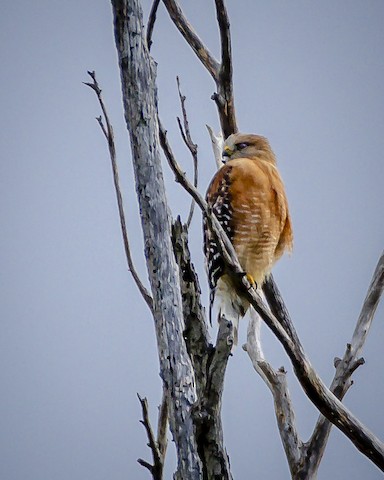Bird Survey – March 2024
Urban Forest Monthly Survey
March 28, 2024
40 Species, 327 Individuals
The weather today was cold, in the 50s, overcast but calm. Lena Hayashi, Betty Kanne (eBird), Jim Kendall, Dave and Sharon Telford, Brenda Sabin, Debra Gala, Deborah Brin, and Brian Bleecker counted all the birds heard and seen in the Urban Forest.
The overcast skies didn’t dull the vibrant colors of the spring blooms throughout the Urban Forest. Again, the most vocal of all the species was the House Wren. They were singing from every direction and scolding sounds were also heard.
One American Robin was heard singing by the creek along Ellis and was seen flying and calling. There were no American Goldfinches today, unlike last month when they were more numerous than the Lesser Goldfinches. Everyone had wonderful looks of a singing Dark-eyed Junco near Annie’s Garden.
A large flock of Tree Swallows circled the sky and most of them headed toward Huntington Lake. However, a sizeable number of paired stragglers continued to check out the nest boxes in the Urban Forest. One pair seemed very set on the nest box on a tree in Mimi’s Garden. Both the male and female perched on branches as if protecting their find from others. The other pair chose a nest box just west of the Volunteer parking lot that in previous years had nesting Western Bluebirds. A pair of Western Bluebirds did investigate a newly built nest box on the hill near the hawk foraging area. They also perched on the branches as if to claim their find. It will be interesting to check these three boxes in the next two months to see if they are successful parents.
It is such a pleasure to conduct these monthly surveys as we can appreciate the tender loving care and artistic talents of the volunteers who place plants, rocks, and limbs of trees in such beautiful arrangements for us to enjoy! We truly notice and appreciate their efforts in sharing their labor of love with us!
We had a wonderful opportunity to use our knowledge and skills of birding to work on the identification of two look-alike birds, the Ruby-crowned Kinglet and the Hutton’s Vireo. The gray sky and foliage, the silent bird(s), along with photos, led to the conclusion that we had one of each. Within the corral of trees, a bird was seen in a Coastal Live Oak, flitting around and most of us had glimpses, leading to a lively discussion of which species it was. One wing bar was seen by several and that led to the Ruby-crowned Kinglet but others saw two wing bars. When it was gone, another bird was seen in another Coastal Live Oak, relatively close to the first. It was heard to make one “scree” scold, leading toward a Hutton’s Vireo. However, both have “scree” scolds. Lengthy bantering went on about the two sightings, was the bill swollen or thin, toes gray or yellowish, where was the dark bar, was the flitting frenetic enough? Was there one or were there two birds? Ahh, the joy of birding among friends!
Below are the species and their numbers. Click the checklist below to enjoy photos taken by the photographers. Once online, you can also click the name of the bird, printed in blue, to open with more information from the Cornell Lab of Ornithology including what sounds the bird makes and its status and distribution.
Checklist S163279388
Sharing links
Main details
Thu 29 Feb 2024
8:06 AM
Totals
Observations
-
Number observed: 4
-
Number observed: 2
-
Number observed: 6
-
Number observed: 5
Media
© Lena Hayashi Macaulay Library © James Kendall Macaulay Library -
Number observed: 2
-
Number observed: 7
Media
© Lena Hayashi Macaulay Library © James Kendall Macaulay Library -
Number observed: 15
Media
© James Kendall Macaulay Library -
Number observed: 2
-
Number observed: 2
-
Number observed: 1
-
Number observed: 2
Media
© Lena Hayashi Macaulay Library © James Kendall Macaulay Library © James Kendall Macaulay Library -
Number observed: 1
Media
© James Kendall Macaulay Library © James Kendall Macaulay Library -
Number observed: 1
-
Number observed: 1
-
Number observed: 1
-
Number observed: 3
-
Number observed: 2
Media
© James Kendall Macaulay Library © James Kendall Macaulay Library -
Number observed: 2
-
Number observed: 18
-
Number observed: 2
-
Number observed: 1
-
Number observed: 10
-
Number observed: 4
-
Number observed: 1
-
Number observed: 16
Media
© Lena Hayashi Macaulay Library © James Kendall Macaulay Library © James Kendall Macaulay Library -
Number observed: 9
-
Number observed: 1
-
Number observed: 6
Media
© James Kendall Macaulay Library -
Number observed: 1
-
Number observed: 42
-
Number observed: 6
-
Number observed: 10
Media
© James Kendall Macaulay Library -
Number observed: 7
-
Number observed: 12
-
Number observed: 4
Media
© Lena Hayashi Macaulay Library © James Kendall Macaulay Library -
Number observed: 2
-
Number observed: 21
-
Number observed: 8
-
Number observed: 1
-
Number observed: 8
-
Number observed: 5
-
Number observed: 18
Media
© Lena Hayashi Macaulay Library






















